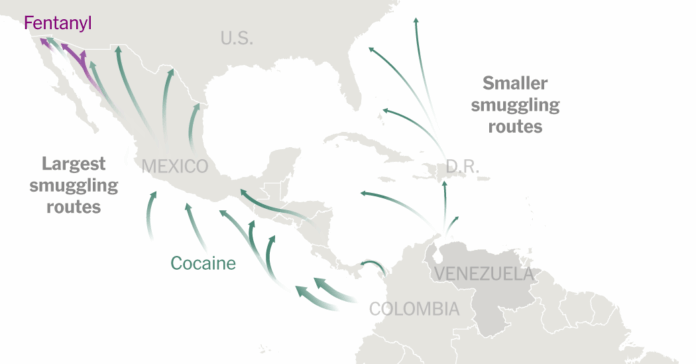The U.S. military has killed at least 21 people in recent strikes on small boats that it says were smuggling drugs off the coast of Venezuela.
President Trump justified the attacks by saying the United States is in an “armed conflict” with drug cartels and vowing to “destroy Venezuelan terrorists and trafficking networks.”
But Mr. Trump’s focus on Venezuela is at odds with reality: The vast majority of cocaine is produced and smuggled elsewhere in Latin America, according to data from the United States, Colombia and the United Nations. And Venezuela does not supply fentanyl at all, experts say.
Here is how those two drugs actually get to the United States.
In the 1980s and ’90s, the Caribbean was the main route for smugglers taking cocaine to the United States. Now, most of that traffic moves through the Pacific.
The Caribbean remains a pass-through point, however. And some countries in the region say that in response to an increased U.S. military presence on the water, some traffickers have started flying their product through the area.
But in recent years, top U.S. officials have rarely mentioned cocaine as a priority. Their focus has been on fentanyl, the drug tied to a national overdose crisis.
Venezuela plays essentially no role in the production or smuggling of fentanyl. The drug is almost entirely made in Mexico with chemicals imported from countries in Asia, including China, according to the U.S. Drug Enforcement Administration, the Justice Department and the Congressional Research Service.
Describing the boats destroyed by the U.S. military off the coast of Venezuela, Mr. Trump has said they carried enough drugs to kill tens of thousands of Americans. He did not specify what drugs.
Cocaine is sometimes mixed in with fentanyl, but when that happens, experts say, it mainly takes place after both drugs reach the United States.
Mexican cartels, including some designated as terrorist organizations by the United States, largely control how drugs like fentanyl, cocaine and methamphetamine cross the border. (The substances mostly come in by land, sometimes concealed in cars or trucks, not by sea.)
The Trump administration has pressed Mexico’s government to do more to stop drugs from entering U.S. territory, but former diplomats and regional analysts say that — American claims notwithstanding — the boat strikes off Venezuela appear to have a different aim.
Some suggest that they may instead be intended to put pressure on Venezuela’s president, Nicolás Maduro, or end his rule altogether. Trump officials have called him an illegitimate leader and accused him of running a cartel. He denies any involvement in drug trafficking.
Whatever effect the strikes have in Venezuela, these experts say they are unlikely to alter the flow of the deadly drugs fueling America’s crisis.
James Story, the American ambassador to Venezuela from 2018 to 2023, said even if the United States achieved limited success, traffickers would regroup.
And using military might to take out small trafficking boats, Mr. Story said, is like “using a blowtorch to cook an egg.”


